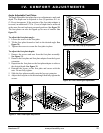
Litestream XF www.pridemobility.com 33
WARNING! Never use any chemicals to clean a vinyl seat, as they may cause the seat to become
slippery or dry out and crack. Use soapy water and dry the seat thoroughly.
Wheel Replacement
Your wheelchair may be equipped with a tire and tube, tire and flat-free insert, or a solid polyurethane tire.
Replacement tires, tubes, inserts, and tire assemblies are readily available through your Quantum Rehab Provider.
WARNING! The wheels on your wheelchair should only be serviced or replaced by a Quantum
Rehab Provider or a qualified technician.
WARNING! When changing a tire, remove the entire drive wheel. If any further disassembly is
required, deflate the tire completely or it may explode.
To replace a pneumatic tire tube, flat-free insert, or solid polyurethane tire:
1. Remove the drive wheel from the frame. See figure 15.
2. If equipped with pneumatic tires, make sure that the tube is deflated completely.
3. Use several tire levers to pry the tire from the rim. Tire levers are available from a bicycle shop.
NOTE: If your wheelchair is equipped with solid polyurethane tires, then no further disassembly is required. Go to step 7.
4. Remove the old tube or flat-free insert.
5. If equipped with pneumatic tires, inflate the new tube with enough air so that it just starts to take shape.
6. If equipped with pneumatic tires or flat-free inserts, install the tube or flat-free insert into the tire.
7. Use the tire levers to secure the tire back onto the rim.
8. If equipped with pneumatic tires, inflate the tire to the psi/bar/kPa air pressure recommended on the sidewall.
Always use a regulated air source.
9. Reinstall the drive wheel to the frame. Make sure that the wheel axle is snapped securely into the frame
bracket.
Manual Wheel Locks
After several months of use, you may find it necessary to adjust the wheel locks so that they lock securely when
engaged. You also may need to adjust them after changing the drive wheel position. Your wheelchair may be equipped
with push-to-lock, pull-to-lock, or scissor-style wheel locks. Adjustment instructions for each are outlined below.
WARNING! If your wheelchair is equipped with pneumatic tires, make sure they are inflated to
the pressure recommended on the sidewall of the tire.
V. CARE AND MAINTENANCE
Figure 45. Wheel Lock Adjustment
TIRE
WHEEL LOCK BLADE
F
R
A
M
E
HARDWARE
To adjust each push-to-lock or pull-to-lock manual
wheel lock:
1. Disengage the wheel lock. See figure 6. The wheel
lock blade should be 0.25 in. (0.64 cm) away from
the tire for both pneumatic and solid tires.
2. Loosen the hardware that fastens the wheel lock to
the frame. See figure 45.
3.
Reposition the wheel lock so that the wheel lock blade
is 0.25 in. (0.64 cm) away from the tire and
perpendicular to the plane of the tire.
4. Tighten the hardware that fastens the wheel lock to
the frame.
5.
Engage the wheel lock and note the position of the blade.
6. Reposition the wheel lock if necessary.
7. Repeat the procedure for the other side.


















